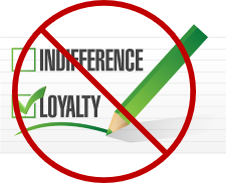Type “customer loyalty” into Google, and you’ll get ads for companies trying to sell you loyalty programs. Below that is a featured snippet from the book The Intuitive Customer which defines customer loyalty as a “result of a consistently positive emotional experience”.
When you really think about it, though, can a loyalty program inspire an emotional response? Who really goes to Starbucks, downloads their customer loyalty app, and feels an emotional connection when they earn their five stars for a Venti coffee? (Only twenty more to go for a free vanilla syrup upgrade.)

The reality is that customer loyalty isn’t a present/absent attribute. There are four different levels of loyalty: Best Option Loyalty, Habit-Based Loyalty, Conscious Loyalty, and Identity Loyalty. If you’re using a card-punch or points-based program to earn customer loyalty, it’s never going to get you past Level 2, and generally won’t even get you there. Here’s what each level looks like.
Level 1: Best Option Loyalty
Customers who reach this level of loyalty visit your auto repair shop because they think you’re the best option at the time. In most cases, it’s because your shop is nearby and they know that you did a good job the last time they brought their vehicle in. It might also be because they’ve got a coupon book from your shop in their car, or they remember a discount you sent them that they can pull up on their smartphone.
This may seem like a weak form of loyalty – and it is. People’s loyalty to most companies they regularly visit never gets past this level, however. They’ll keep bringing their vehicles into your shop until they notice a good reason to walk away. That could be a big discount at a competitor, a strong referral to another shop, or an annoying experience at your shop. That might take years – or it might happen tomorrow.
Level 2: Habit-Based Loyalty
If a customer comes to your shop enough times, it will become a habit. The average person makes thousands of decisions per day – several per minute. It’s exhausting, which is why most decisions aren’t conscious. Most decisions are based on habit – when you decide to set your alarm clock, you set it for the same time every morning unless you have a good reason to change it. And if people visit your shop enough times, they’ll keep coming to your shop unless they have a good reason to stop doing it.
At this point, a $10 off coupon from a competitor, or a minor annoyance during a visit to your shop, isn’t going to get them to change their behavior. Changing shops requires too much effort. Is the other shop rated well? Where is it? Is a ride available to work? Is there a restaurant nearby for food while waiting? Going to the trouble of figuring all of this out will require an emotional reason.
They will still change shops if they have an emotional reason to do so, however. They’ll also do it if they decide that their habit no longer makes sense – for instance, if they move or change jobs, and your shop isn’t convenient anymore.
Level 3: Conscious Loyalty
To reach this level, customers have to feel like you’ve done something for them that is far outside of the norm for your industry. Unlike lower levels of loyalty, this is an emotional connection – “I go to a shop because they’re the only one that does X for their customers” is generally an emotional statement.
It doesn’t necessarily have to be anything expensive either. It could be a simple gesture like adding a free service to an expensive bill after they’ve already agreed to pay for it. Even a hand-written thank you note is surprising these days.
Ironically, this loyalty is often created out of the ashes of a bad experience. When customers complain about the quality of service they receive, they expect some acknowledgement of the response (and some unethical customers take advantage of this fact). But they don’t expect compassion – in a world full of publicly traded companies and 1-800 customer service lines, it’s just not common anymore.
At small businesses, however, customers often experience something unexpected when they get bad service. A manager or owner admits the error, owns responsibility for it, apologizes, and makes a generous offer to make up for it. At this point, a mixture of surprise at the response and guilt for making a big deal out of it can lead the customer to want to repay the kindness.
Level 4: Identity Loyalty
Most people only have a couple of brands in their lives that form a part of their identity. Vehicles are actually one of the few items where it’s common for customers to identify with a brand. Most people who drive Harleys or Corvettes don’t do it because it was cheaper or had a better warranty than competing products. They do it because they think the vehicle represents them personally.
Once customers reach this level, it takes a tremendous level of effort to get them to change products. In fact, the only way they’ll change brands is if the product or service lets them down in a very substantial way or challenges some other aspect of their identity. That’s because using a different product requires more than changing a product – it requires changing who they are and how they see themselves. Most brands have to invest a tremendous amount of money and effort to ever have a chance at earning customers with Identity Loyalty, which is why most small businesses don’t have any customers who reach this level.
To learn how Repair Shop Websites can bring new customers into your shop, call us at 855-394-6397 or email us at Team_RSW@RepairShopWebsites.com.